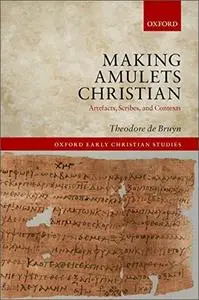Making Amulets Christian: Artefacts, Scribes, and Contexts (Oxford Early Christian Studies) by Theodore De Bruyn
English | September 27, 2017 | ISBN: 0199687889 | True PDF | 312 pages | 20.2 MB
English | September 27, 2017 | ISBN: 0199687889 | True PDF | 312 pages | 20.2 MB
Making Amulets Christian: Artefacts, Scribes, and Contexts examines Greek amulets with Christian elements from late antique Egypt in order to discern the processes whereby a customary practice–the writing of incantations on amulets–changed in an increasingly Christian context. It considers how the formulation of incantations and amulets changed as the Christian church became the prevailing religious institution in Egypt in the last centuries of the Roman empire. Theodore de Bruyn investigates what we can learn from incantations and amulets containing Christian elements about the cultural and social location of the people who wrote them. He shows how incantations and amulets were indebted to rituals or ritualizing behavior of Christians.
This study analyzes different types of amulets and the ways in which they incorporate Christian elements. By comparing the formulation and writing of individual amulets that are similar to one another, one can observe differences in the culture of the scribes of these materials. It argues for 'conditioned individuality' in the production of amulets. On the one hand, amulets manifest qualities that reflect the training and culture of the individual writer. On the other hand, amulets reveal that individual writers were shaped, whether consciously or inadvertently, by the resources they drew upon-by what is called 'tradition' in the field of religious studies.



